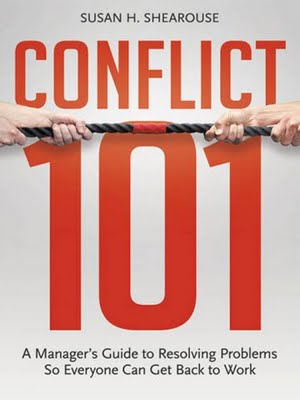Conflict 101 [Book Review]
This blog is reader-supported. When you purchase something through an affiliate link on this site, I may earn some coffee money. Thanks! Learn more.
Read our review guidelines.

Susan H. Shearouse covers everything from why we are bad at dealing with conflict at the office, how the dynamics of conflict situations work and most importantly, how to resolve conflict. There’s even a section on the sorts of conflict caused by poorly written emails and your project communications could drastically improve from just reading that bit.
I had had a particularly difficult week at work when I picked this book up. It was a Friday night, and I started reading it on the tube on the way home. I read:
Someone says something, and we are sparked to anger. Suddenly we’re standing in the middle of the room, yelling at someone else. Or slamming the door and stomping out of the room. The label ‘conflict’ is slapped on the event, and we walk away embarrassed and ashamed. “How could I have said that to her?” “Why didn’t I just let that go?” We turn these moments over and over in our heads, feeling lousy about who we are and what we have done and because of how we reacted.
Shearouse goes on to say that it’s OK to feel awful. Reading the introduction to this book made me feel instantly better about my week. I felt even better when I noticed a random act of kindness in my tube carriage – a man helping a nun with her bags.
Stop The Blame Game
The aim of the book is to help you manage better by resolving conflict at a lower level – before it gets to the point where you yell at your project team for not working hard enough. Shearouse reminds us that conflict is inevitable, but that you can get over it. One of the first steps is to step away from the blame game. She writes:
Assigning blame to someone else is a delicious temptation. It looks like the conflict will be much easier to address or to resolve if we can first figure out whose fault it is. Then, if we can fix the individual, the problem is solved. When we look further into the conflict, however, nine times out of ten we have had some role in creating, contributing to, or exacerbating the situation… Time spent assigning blame is only time not spent in finding a way forward.
The book includes dozens of stories, and these were my favourite part. As someone who has worked with dysfunctional teams for years, Shearouse has plenty of real-life examples to draw on. I did get a bit lost when she described passive aggressive behaviour as ‘like grits popping in a pan.’ I don’t know what grits are – porridge? Even Wikipedia didn’t make this any clearer.
5 Responses to Conflict
Chapter 5 focuses on the 5 responses to conflict:
- Avoiding
- Accommodating
- Directing
- Compromising
- Collaborating
What I found helpful to understand is that while we might have a personal preference for conflict handling (mine is the Run For The Hills approach), each response has its place.
For example, Avoiding is great to stop conflict over the small stuff, or when you need time to cool off before dealing with a problem. It can also work well when you know you aren’t going to win, like when your project sponsor wants you to implement a new change that you don’t agree with.
Save your energy for situations where tackling the conflict will move you closer to a resolution and stop banging your head on a brick wall.
The Role of Culture
The book also makes the reader question the assumptions we bring to situations. These assumptions can create conflict without even trying. For example, the project accountant will always be detail-orientated and fail to see the big project picture. That assumption will change the way you deal with the accountant and could create conflict.
Shearouse points out that as individuals we are the product of our upbringing and society, and that what we might react to will be completely different from the issues that press someone else’s buttons. Being aware of our own views is a big step forward to understanding why conflicts arise and our role in them.
This book is now quite battered as I refer to it frequently. It is not specifically aimed at project managers but it’s essential reading for any project manager who has a challenging project or a challenging team.
